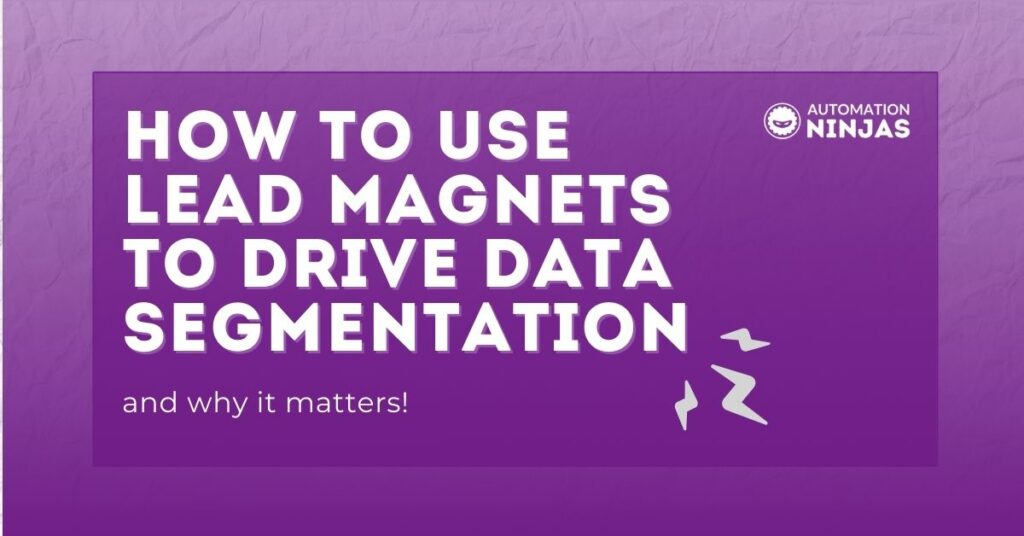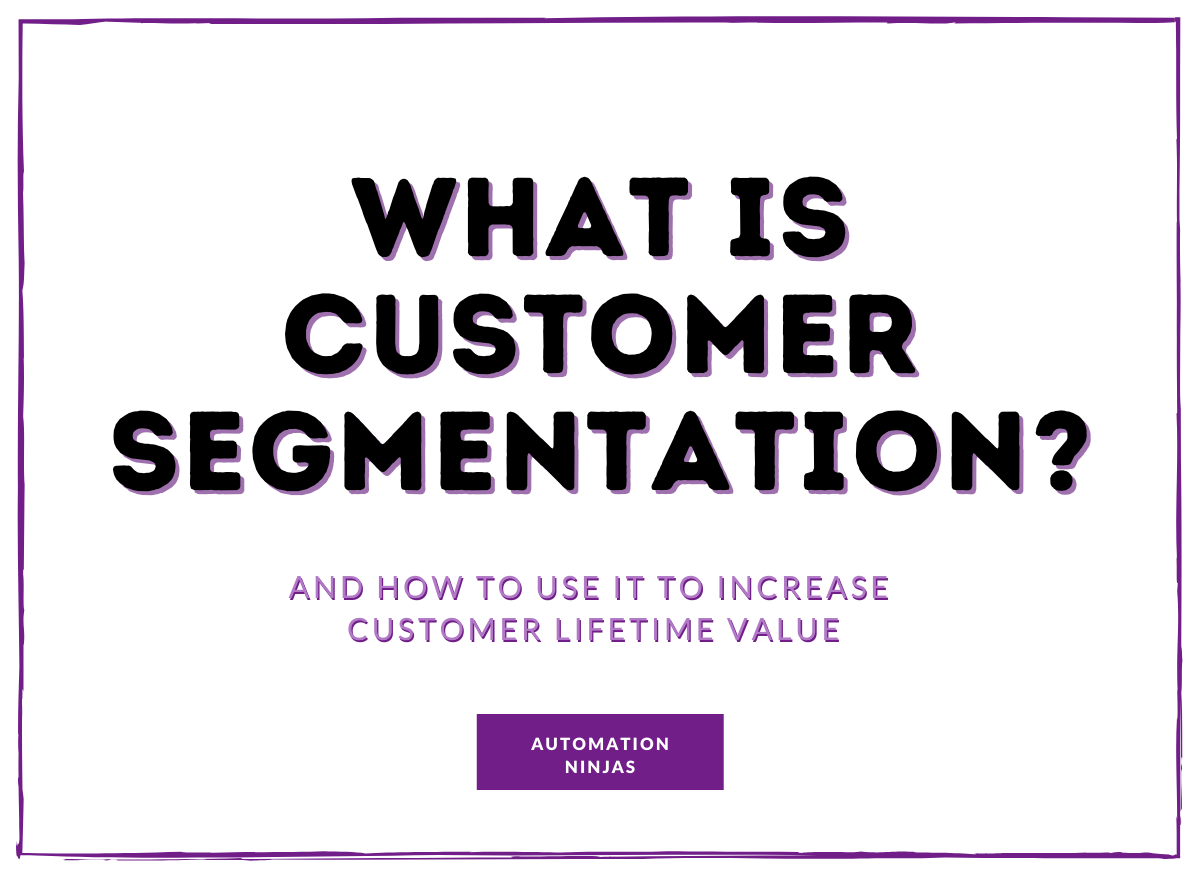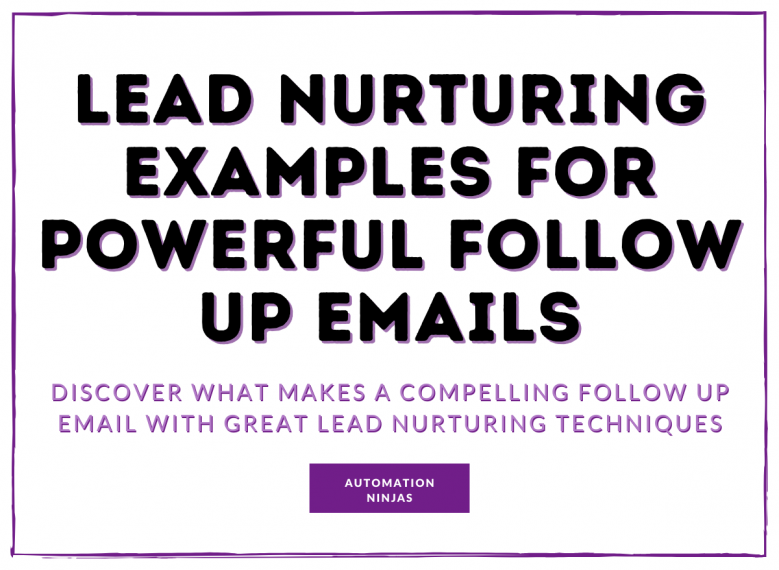Data segmentation is critical to understanding what a lead engages with and how they behave and intersect with content.
Imagine for a minute that you are an experienced furniture upcycler 
The key word here is “experienced”, meaning you already know what you need, so this lead magnet goes to your inbox to die. Why? Because the paint supplier hasn’t used segmentation to figure out what to serve their audience at the right time.
The right lead magnet at the right time can be the spark that leads to a brilliant consumer relationship. Lead magnets can be extremely effective and, in our opinion, essential to capturing and nurturing potential customers.
However, it’s a sad fact that many people will sign up for a lead magnet and then ignore it - engagement level zero. It goes unopened, unloved, and unable to convert.
This is what we want to avoid
So, it’s essential to use your lead magnets correctly. And part of this is in understanding how lead magnets can fuel extensive data segmentation - i.e. knowing where your customers are in their buying journey.
Knowing this enables you to push potential customers along the awareness stages - eventually to purchase (and repeated purchase).
In this article, we’ll explore what lead magnets are, how businesses use them wrong, and how to integrate segmentation and lead magnets to drive demand generation.
What is data segmentation?
Firstly let’s take a look at understanding what we mean by data segmentation.
Data segmentation is the process of dividing potential and existing customers using specific criteria that allows you to tailor their buying experience specifically to them.
Simply speaking, it’s a way to segment your customer base so you can present the most relevant information to them at the right time. There are multiple different ways to segment your customer data.
Demographics are one way and are typically used by most businesses. For example
- Age
- Gender
- Personality
- Income
- Interests
- Spending habits.
However, let’s go one step further and look at segmentation based on psychographics and behaviour. It’s a stronger way of segmenting, and the data is more powerful than demographics alone.
Psychographic & Behaviour Data Segmentation
Psychographic and behavioural data segmentation is truly powerful and allows you to profile your potential customers and leads based on how they interact with content. So much so that we wrote a full blog on it here.
Behavioural progressive profiling enables you to segment your data cleverly, allowing you to learn more about your potential customers based on their progressive interactions. One of those interactions would be the lead magnets your potential customers consume.
Regardless of how you segment your customer data, it’s essential to outline your business and marketing objectives. This will allow you to split potential and existing customers into relevant segments with similar characteristics. Data segmentation helps to effectively tailor communication in a more personalised way that resonates with your target audience.
Related content: Behavioural progressive profiling - drive demand generation.

How to use your lead magnets for data segmentation?
We talk about lead magnets a lot (it’s our job). And we’re aware of just how powerful they are if used effectively.
By this point, you probably know what a lead magnet is (if not, here is a reminder):
A lead magnet is any FREE valuable asset that incentivises potential customers into your database. Usually, you offer them something in exchange for their contact information.
If you want to read about lead magnets before we go any further, you can read about them here.
What we’re interested in here is how to use these lead magnets in a strategic way for data segmentation. And then how that information can be used to enhance engagement and conversions.
Are you using your lead magnets correctly?
Let’s get one thing straight - lead magnets can be anything valuable. But that doesn’t necessarily mean that all lead magnets get used effectively.
It’s not just about exchanging information for contact details - well, not if you want it to be a valuable lead generation tool - it’s about what you do with this information once you have it.
Lead magnets are effective ways to help you understand your audience's interests and allow you to serve them better.
How?
Potential customers are interested in different types of lead magnets at varying stages of the buyer’s journey.
It’s common for businesses to create generalised lead magnets with no specific target audience or awareness stage in mind (more on this later).
Back to our original example, a paint supplier might create a “what you need for upcycling furniture” checklist and distribute it with a shotgun approach to all potential clients. However, this isn’t necessarily relevant to their entire audience, and having no clear audience for the lead magnet creates depersonalised content.
Generic lead magnets and content doesn’t offer valuable insights for a large portion of your audience. You need to know where your potential customers are in the buying cycle and give them what they need and are asking for.
Related content: How to create strategic lead magnets?
An example of poor data segmentation using lead magnets
One of the biggest mistakes we see with lead magnets is only focusing on bottom-of-funnel content and the supporting lead magnets to drive sales and conversions. For example, they might have a buyer’s guide or a product discount - but nothing to help nurture people earlier in the buying journey.
Why?
Because not everyone visiting your website is sales-ready: a study by Episerver showed that 92% of first-time website visitors were not yet ready to buy.
Meaning that the bottom-of-funnel lead magnets will be ineffective, so you need to create lead magnets for every stage of awareness.
Let’s again pretend to be a paint supplier for this example. You have two different types of customers: Customer A and Customer B.
Customer A is new to upcycling furniture; they don’t really know what they are doing and are looking for hints and tips to make their first piece of furniture as easy as possible. They download your lead magnet, a checklist for “what you need for upcycling furniture”. It’s a popular lead magnet, but they just aren’t ready to commit to the purchase yet.
Customer B is a professional furniture flipper. They know what they are doing and are looking for a company to become their regular supplier. But they don’t need the checklist, and you don’t have a lead magnet targeted to this type of customer, so they don’t engage with you.
So, data segmentation allows you to separate these two types of customers based on different demographics, and this empowers you to make the right lead magnet to cater to them.

How should you be using lead magnets alongside data segmentation?
So, as above, you need to segment your customer data, understand their level of awareness and create a lead magnet that caters to this. If not, you’ll offer potential buyers something that isn’t right for them, and they won’t consume it.
How?
A clever little reverse engineering allows you to create a valuable lead magnet at specific awareness stages. And in addition, it will help you learn more about your potential customers along the way.
As we said, the end goal isn't to get the contact details from customers; it’s to use lead magnets to track where your audience is in their individual customer journey.
To do this, you need to consider the awareness stages and their problems.
Data segmentation enables you to determine the most appropriate solutions, and this will inform the lead magnet you need to create to serve this audience. We recommend at least one lead magnet per awareness stage to move people through the buyer journey.
It’s significant for B2B businesses, as your ideal customers can spend months (if not years) in the buying cycle. And you need to nudge them along the journey while maintaining contact.
You can find out more about the awareness journey here.
An example of awareness in lead magnets
Each lead magnet should specifically cater to different customers' relevant points in the awareness journey. It’s not about creating a single lead magnet and expecting it to do all the heavy lifting for every single type of customer.
Awareness stages are essentially the steps of the buyer’s journey. However, we are looking at a prospects awareness stage in this example.
Again, Customer A is at the top of the awareness journey, trying to figure out their problem. They are not yet ready to buy and shouldn’t receive lead magnets to do with sales info or buyer’s guides.
Whereas Customer B is clear on their problem, solution and the sort of products (paint) they need. They are ready for sales solutions and buyer’s guides. If you were to send them top-of-funnel lead magnets, it would be as ineffective as sending Customer A bottom-of-funnel ones.
They need different things.
If we aren’t tracking engagement and behaviour with content and lead magnets of all types, we cannot use data segmentation to inform us of what to do and when.
Need help with your segmentation or lead magnet strategy?
Lead magnets are powerful - there is no doubt about that. But you must fully understand how to implement them as part of your marketing strategy.
We know from experience that businesses are not utilising lead magnets and data segmentation to their full potential. They aren’t just a tool to build your contact list but to understand where your potential customers are in their buying journey. Knowing this enables you to tailor the buying experience to the right customer at the right time.
Need a little more help with this?
Get in touch and see how our ninjas can help you with data segmentation and lead magnets.






